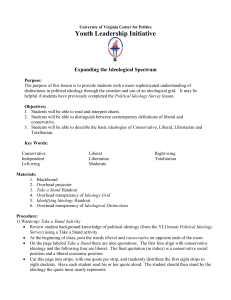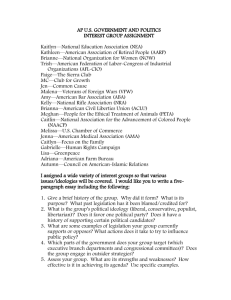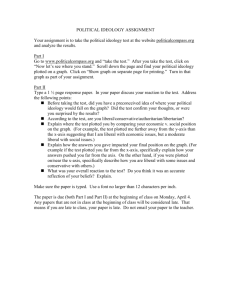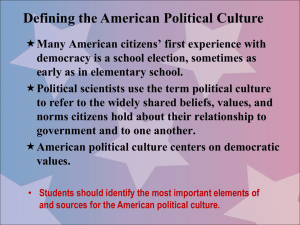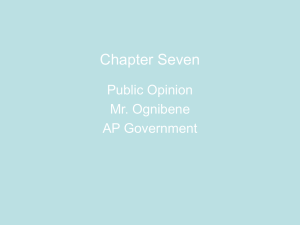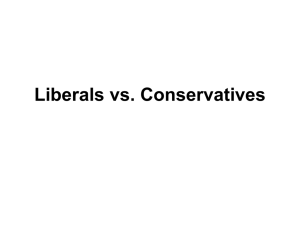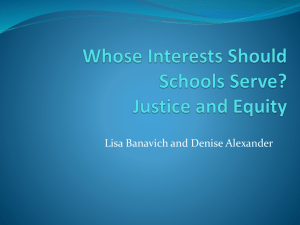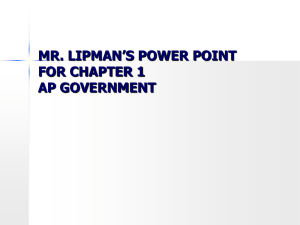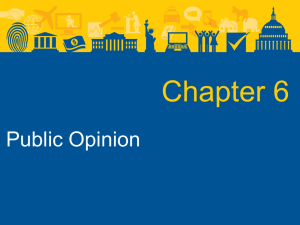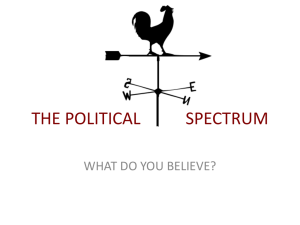Expanding the Ideological Spectrum
advertisement
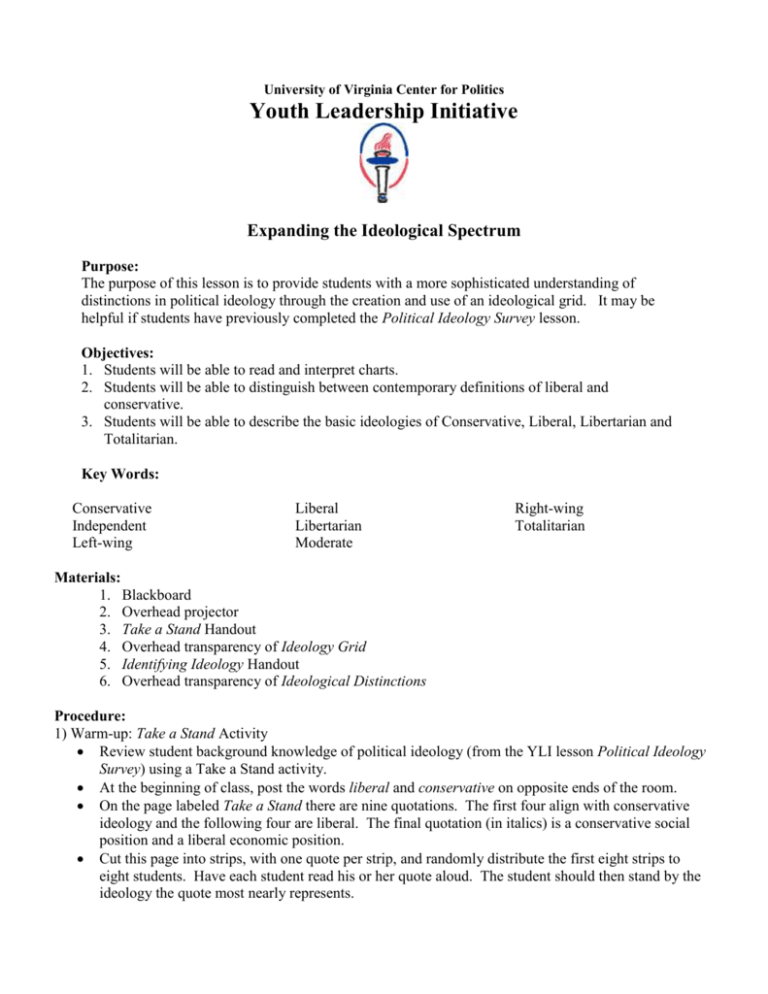
University of Virginia Center for Politics Youth Leadership Initiative Expanding the Ideological Spectrum Purpose: The purpose of this lesson is to provide students with a more sophisticated understanding of distinctions in political ideology through the creation and use of an ideological grid. It may be helpful if students have previously completed the Political Ideology Survey lesson. Objectives: 1. Students will be able to read and interpret charts. 2. Students will be able to distinguish between contemporary definitions of liberal and conservative. 3. Students will be able to describe the basic ideologies of Conservative, Liberal, Libertarian and Totalitarian. Key Words: Conservative Independent Left-wing Liberal Libertarian Moderate Right-wing Totalitarian Materials: 1. Blackboard 2. Overhead projector 3. Take a Stand Handout 4. Overhead transparency of Ideology Grid 5. Identifying Ideology Handout 6. Overhead transparency of Ideological Distinctions Procedure: 1) Warm-up: Take a Stand Activity Review student background knowledge of political ideology (from the YLI lesson Political Ideology Survey) using a Take a Stand activity. At the beginning of class, post the words liberal and conservative on opposite ends of the room. On the page labeled Take a Stand there are nine quotations. The first four align with conservative ideology and the following four are liberal. The final quotation (in italics) is a conservative social position and a liberal economic position. Cut this page into strips, with one quote per strip, and randomly distribute the first eight strips to eight students. Have each student read his or her quote aloud. The student should then stand by the ideology the quote most nearly represents. Youth Leadership Initiative Read the final quote aloud and asks students where a person like this would best fit on the twodimensional spectrum. Explain that the traditional two-dimensional spectrum is limited in its ability to illustrate the broad range of individual political beliefs. Have students discuss what the words independent and moderate mean to most of them. Help them transfer their basic understandings to distinguish between the political terms Independent, a person not affiliated with any one political party, and Moderate, a person opposed to extremes in political beliefs. 2) Show the Refining Political Ideology overhead. Explain that liberals and conservatives often disagree about the role of government. Conservatives tend to believe that there should be less government intervention in economic matters, while liberals feel there should be less governmental regulation of social and political matters. This should help to demonstrate the limitations of the traditional spectrum. 3) Show students how the two spectrums can be combined by using a grid. Make a transparency of the Ideology Grid or draw the grid on the board. Introduce the terms libertarian, minimal government control of both economic and social issues, and totalitarian, complete government control of economic and social issues. 4) Distribute the handout Identifying Ideology. Have students work individually or with a partner to plot the ideology of the person described in each scenario. Have students share their answers. 5) Explain to students that some issues like crime and punishment do not fit on the spectrum very well. Use the additional overhead/handout, Other Ideological Distinctions, to explain other differences between modern liberals and conservatives. Extension Activities: 1) Assign students (individually or in small groups) an issue in the news, such as immigration or stem cell research. Have students write an imaginary dialogue about the issue between four characters, a liberal, a conservative, a libertarian, and a totalitarian. The dialogue should demonstrate areas of difference and areas of agreement between the ideologies. If given as a group assignment, students could perform their dialogue as a skit. 2) Discuss other areas of ideological differences. For example, most conservatives favor a strict constructionist view of interpreting the Constitution, while liberals favor a loose construction. How can the political ideology of a president shape the way laws are interpreted by the courts? 3) Often, liberals are described as favoring change while conservatives oppose it. Ask students to generate lists of liberal and conservative positions that might support this assertion. Public schools should begin each day with a prayer. T a k e a Businesses operate most efficiently when they determine how much their workers earn. Government should not set a minimum wage. Law-abiding citizens should have no limit on the number of guns they may own. Individual people should rely on their own hard work to achieve financial stability. Religion and public schools should be kept separate. The minimum wage is a great example of how the government can protect workers from being taken advantage of by businesses. Gun control laws are an important way to protect public safety. Sometimes the poor need financial help from the government. I believe that the government should be able to censor books and movies with offensive language. I also believe that government regulations on business help protect our environment. S t a n d Youth Leadership Initiative REFINING THE IDEOLOGICAL SPECTRUM LIBERAL CONSERVATIVE The Economic Spectrum Economic liberals favor broad government involvement in economic policymaking and regulation of business. Examples: Economic conservatives favor limited government involvement in economic policymaking and regulation of business. Examples: LIBERAL CONSERVATIVE The Social/Political Spectrum Social and political liberals favor limited government regulation of individual behavior. Examples: Social and political conservatives favor broad government regulation of individual behavior. Examples: Youth Leadership Initiative IDEOLOGY GRID Govt. control Totalitarian Definition: Social/Political Conservative Definition: Libertarian Definition: Liberal Definition: Freedom Economic Govt.Control Youth Leadership Initiative IDENTIFYING IDEOLOGY Read each of the quotes below. For each quote decide if the speaker is likely a liberal, conservative, libertarian, or totalitarian. When you have made your decision, put the letter of the quote where you feel it belongs on the ideology grid. Voter A: “I worked my way up from poverty to become the successful business owner I am today. I get frustrated when I think that my tax money goes to support people who won’t help themselves. I think part of the blame belongs with the media – they promote all the wrong values.” Voter B: “I really don’t care what other people do in their free time, as long as they don’t bother me. I sure don’t like it when the government tells me what to do with my money or in my own home – I’m certainly not going to turn around and do the same thing to my neighbors.” Voter C: “I really worry about the state of the world today. It seems like more and more kids are growing up in poverty and there’s no one there to help them. I think we need to do more toward providing healthcare and education programs for our young people.” Voter D: “These days, you can’t be too careful. I think we need to spend a lot more money on the national defense. I wish there was a police officer on every corner! The police could search my car all they want, since I don’t break the law. I also think the government should crack down on the media – their reporting gives our enemies an inside look at all our military preparations.” Ideology Grid Govt. control Social/Political Conservative Libertarian Totalitarian Liberal Freedom Economic Govt. Control Youth Leadership Initiative IDEOLOGICAL DISTINCTIONS ISSUE LIBERAL VIEWS CONSERVATIVE VIEWS Interpretation of the United States Constitution Favor loose construction – Constitutional interpretation may change as modern society evolves Favor strict construction – Constitutional interpretation should remain constant through the years Tradition vs. Change Favor change over status quo Favor tradition over change
